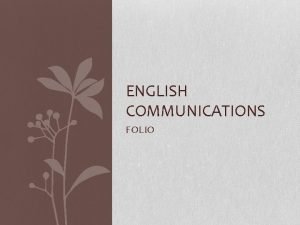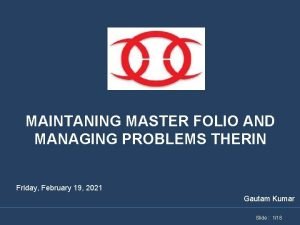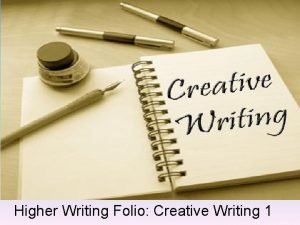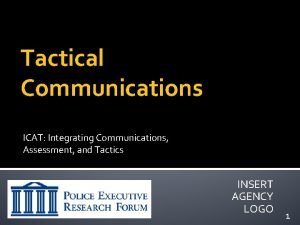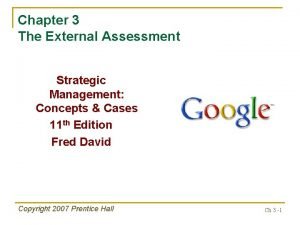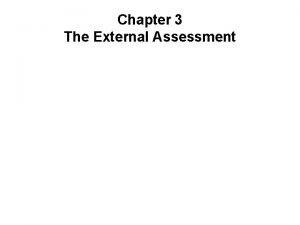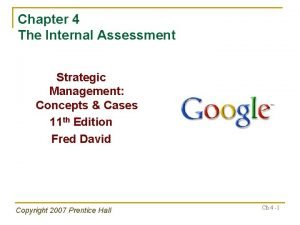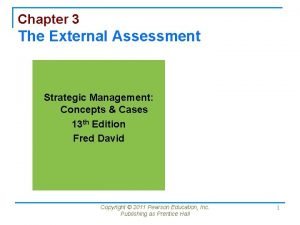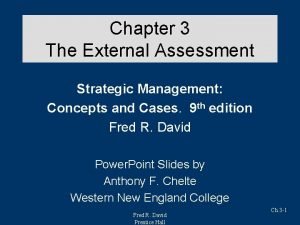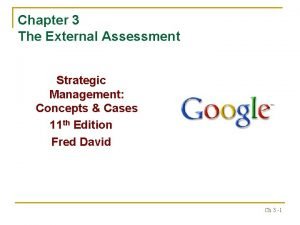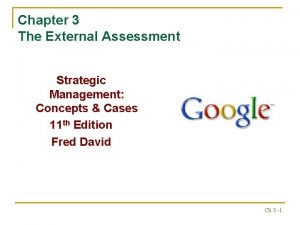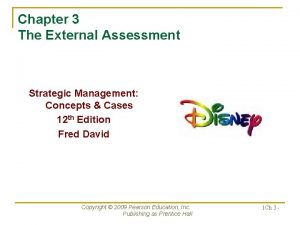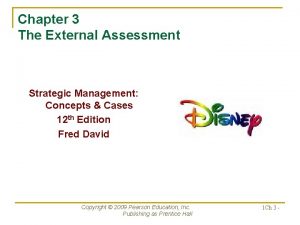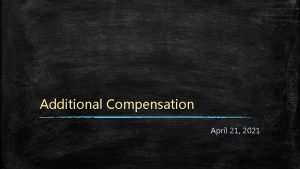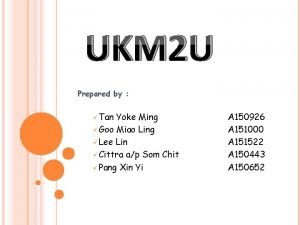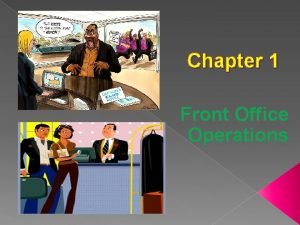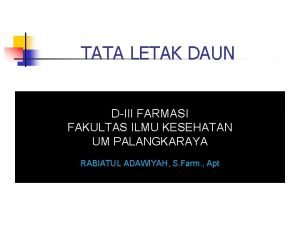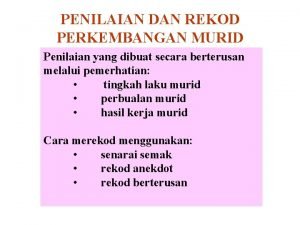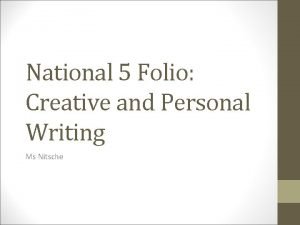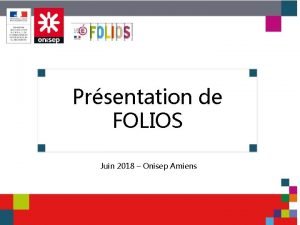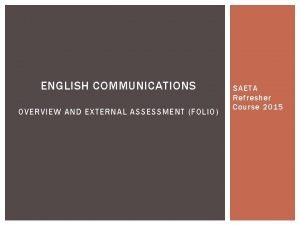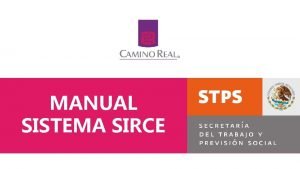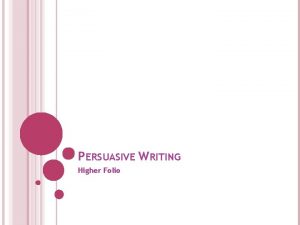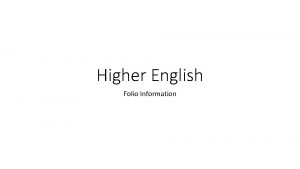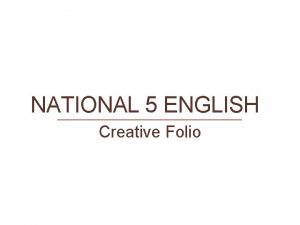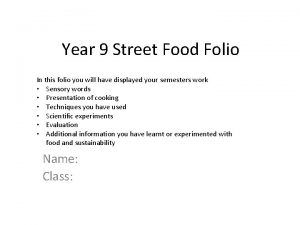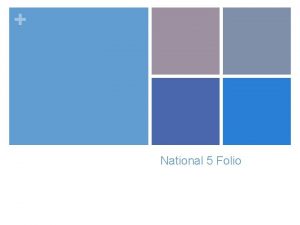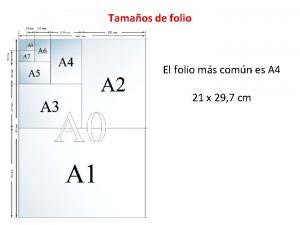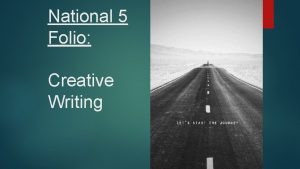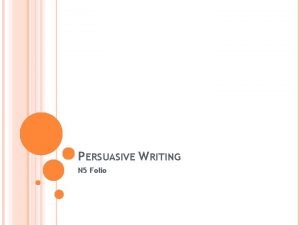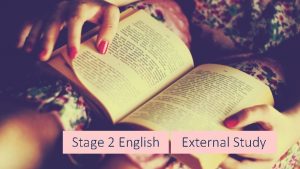ENGLISH COMMUNICATIONS FOLIO Assessment Type 4 Folio External






























- Slides: 30

ENGLISH COMMUNICATIONS FOLIO

Assessment Type 4: Folio (External) The Folio is “a product of independent study” - –”there were some classes where it was evident that students had very limited choice for both parts of the folio and this had an impact on the marks that were allocated. ” Chief Assessors Report 2014 Students do best when they demonstrate they can write for two purposes and audiences across the folio Challenging texts and forms of writing were better options than texts that were very familiar to students

Things to avoid: Folios where Part 1 & Part 2 were connected in some way were not as successful at meeting the performance standards to a high degree (e. g. responding to a persuasive speech and writing a persuasive article) The performance standards make it clear that students who have considered the purpose, language, context and audience of a range of texts are best positioned to score highly

Other considerations: • Consistency across all parts of the folio is necessary rather than over-drafting one part only. Chief Assessors Report 2014 • In 2014 there was much greater evidence of students undertaking research on the internet for material to assist in the completion of the folio (often with appropriate acknowledgements) BUT This tended to make the piece of work highly derivative and as a result the student’s own voice could not be heard.

Part 1: Response to an example of Communication Responses that were guided by a well-worded topic or question were the most successful Questions that contained words such as “language techniques”, “appeal to the audience, ” “stylistic features” or “effects on the reader or listener” directed students most appropriately. For example – “Discuss the effectiveness of the film techniques the director uses to explore the idea of …. . ” OR “How does the author of “The Book Thief” use specific techniques to position the reader to …”

Questions that focused on content, characters or themes did not give the students enough scope to address KU 1, 2, 4 &An 1. For example – “How effectively does the director explore theme of……” OR “How does the main character develop as the novel progresses? ”

Observations: The better responses focused on specific structural and language features and their connection to the audience (with close reference to their chosen text). An entire essay devoted to the student’s opinion of the text does not display knowledge about how the text was constructed. Students who named the creator of the text, outlined what techniques they were discussing and mentioned audience in the introduction, steered the response to meet the performance standards at the highest levels.

Popular Choices film texts novels plays poetry articles speeches film trailers documentaries *These forms all have significant language elements.

Problem Choices: Texts with minimal language elements e. g. . Advertisements with strong visual compositions on-line or computer games song lyrics music videos apps for phones and ipads DVD covers packaging of consumable items an entire television series

• Texts with little language, such as advertisements that rely on visual impact, disadvantaged students. Students here tended to sacrifice language form – “Students are reminded that their comments must be from an English perspective, rather than a design perspective. ” Chief Assessors Report 2014

INDEPENDENCE IS THE KEY WORD! • A situation that reduced the level of independence was when students chose their own text from within a text type, but had to write an essay in which the paragraphs were on specified film conventions regardless of whether they were the most appropriate for that film or not. • Other highly scaffolded responses (such as generic paragraph starters) also resulted in a lack of individuality and reduced interpretation of the text.

Novels • The Book Thief • The Curious Incident of the Dog In the Night • The Cellist of Sarajevo • That Eye, The Sky • Fly Away, Peter • The Great Gatsby

Films Students who chose favourite films such as romantic comedies, teen dramas, sports drams and animated films did not tend to analyse them critically, preferring to focus on plot, theme or character. This prevented them from demonstrating high achievement for KU 3&4 and An 1. Successful films in 2014 included: • The Book Thief • The Black Swan • The Great Gatsby • Hugo • The Grand Budapest Hotel • Into the Wild • Django Unchained

Speeches • Analyses of speeches presented at TED talks were popular, and expanded on the more traditional speeches chosen by students in previous years. • Whilst good analysis of the speech itself was generally present, an element that was often overlooked was the mode of delivery of the speech (i. e. . tone, modulation, pace, expression and how these contribute to the overall effectiveness of the speech)

Single Text Only. • Students should not be comparing two examples of communication because it is outside the Subject Outline scope

The essay was the most popular choice for Part 1. The better essays had: • Clear introductions • Topic sentences • Summary sentences • Effective use of evidence • Strong conclusions • Clear links to the question being answered Please note that An 2 has no place in the Folio, and questions that encourage students to make connections between their own ideas and those expressed in the text should be avoided.

Other Tips: • Titles of texts must be in italics or quotation marks (and correct use of capitals must be evident) • The integrated inclusion of evidence through quotations and examples is crucial in demonstrating sophisticated communication skills and high achievement of Ap 2 • Students who listed a number of linguistic techniques but did not provide the evidence to support their claims were compromised. • Some students attempted to analyse too many aspects of their chosen text – their responses had breadth but lacked depth.




Part 2: Text Production with Writer’s Statement • Students were most successful when they chose a style of writing that allowed them to employ a range of stylistic features that they could then discuss and justify in the Writer’s Statement. • Independent choice is important here – students should have the opportunity to showcase their skills in a particular genre or area of interest. • Whatever the form, the best pieces of writing were ones in which the student’s voice was discernible, and control over language was evident.

Successful choices original articles for magazines play scripts opinion pieces (to persuade or communicate a point of view)) taking students to a specific location and using it as a prompt for their writing (creative or functional) Narratives poetry vignettes

• Persuasive pieces of writing were a good choice, and the accompanying Writer’s Statement clearly outlined rhetorical techniques that had been used and the intended effect on the audience.


Problem Choices: brochures (riddled with plagiarism) letters of complaint picture books simplistic poetry stories based on the paranormal (lacked a unique voice) writing that relied heavily on factual or researched information Video games

Things To Avoid: • Writing that relied heavily on factual or researched information, (such as diseases, smoking, celebrities and sport stars) tended to lack originality • Instructional writing also tended to limit high achievement • In both of these cases, students usually did not use sophisticated language to produce creative texts. • Other types of writing that were formulaic and derivative were stories based on the paranormal or video games.


Writer’s Statement 300 -500 words seemed the most successful length the more successful students clearly identified the intentions behind the writing and their target readers – explaining the language techniques they had used with examples Weaker students used this section to focus on the form rather than the language used Dot points should be avoided as they do not allow for a cohesive discussion. Students are advised to avoid a lengthy explanation of the ideas behind the writing at the expense of justifying the language decisions made


 Folio assessment
Folio assessment Master folio
Master folio Higher english folio
Higher english folio Integrating communications assessment and tactics
Integrating communications assessment and tactics External-external trips
External-external trips Internal and external assessment in strategic management
Internal and external assessment in strategic management Importance of external assessment in strategic management
Importance of external assessment in strategic management Internal assessment in strategic management
Internal assessment in strategic management Internal and external assessment in strategic management
Internal and external assessment in strategic management Competition in virtually all industries is
Competition in virtually all industries is Cpm matrix
Cpm matrix Internal and external assessment in strategic management
Internal and external assessment in strategic management Internal and external assessment in strategic management
Internal and external assessment in strategic management Expound the external assessment
Expound the external assessment External vulnerability assessment definition
External vulnerability assessment definition Example of three column cash book
Example of three column cash book Folio tracker biossmann
Folio tracker biossmann Folio erm
Folio erm Ucsb ap folio
Ucsb ap folio Ukm campus 2u
Ukm campus 2u Expert system adalah
Expert system adalah Personal reflective essay ideas national 5
Personal reflective essay ideas national 5 Higher photography
Higher photography Folio bucket in front office
Folio bucket in front office E-folio template
E-folio template Tata letak daun berhadapan
Tata letak daun berhadapan Tindakan susulan daripada hasil penilaian
Tindakan susulan daripada hasil penilaian National 5 folio
National 5 folio Folio.onisep
Folio.onisep Folio teacher evaluation
Folio teacher evaluation Sistema sirce
Sistema sirce
